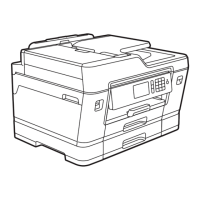
Do you have a question about the Brother MFC-J3530DW and is the answer not in the manual?
| Secure printing | Yes |
|---|---|
| Print technology | Inkjet |
| Maximum resolution | 4800 x 1200 DPI |
| Duplex printing mode | Auto |
| Time to first page (black, normal) | 6 s |
| Print speed (black, normal quality, A3) | 22 ppm |
| Print speed (color, normal quality, A3) | 20 ppm |
| Print speed (black, normal quality, A4/US Letter) | 35 ppm |
| Print speed (color, normal quality, A4/US Letter) | 27 ppm |
| Copier resize | 25 - 400 % |
| Maximum copy resolution | 1200 x 4800 DPI |
| Maximum number of copies | 99 copies |
| N-in-1 copy function (N=) | 2, 4 |
| Copy speed (black, normal quality, A3) | 12 cpm |
| Copy speed (color, normal quality, A3) | 9 cpm |
| Scan to | E-mail, E-mail Server, FTP, File, Image, OCR, USB |
| Grayscale levels | 256 |
| Input color depth | 48 bit |
| Output color depth | 24 bit |
| Scan speed (color) | 8 ppm |
| Input grayscale depth | 16 bit |
| Output grayscale depth | 8 bit |
| Maximum scan resolution | 19200 x 19200 DPI |
| Optical scanning resolution | 1200 x 2400 DPI |
| Faxing | Color faxing |
| Fax memory | 200 pages |
| Fax forwarding to | E-mail, Fax, PC |
| Fax transmission speed | 33.6 sec/page |
| Fax speed dialing (max numbers) | 250 |
| Digital sender | No |
| Printing colors | Black, Cyan, Magenta, Yellow |
| Maximum duty cycle | - pages per month |
| Number of print cartridges | 4 |
| Wi-Fi standards | 802.11b, 802.11g, Wi-Fi 4 (802.11n) |
| Cabling technology | 10/100Base-T(X) |
| Security algorithms | 64-bit WEP, 128-bit WEP, 802.1x RADIUS, IPSEC, SMTP-AUTH, SNMPv3, SSL/TLS, WPA-PSK, WPA2-PSK |
| Ethernet LAN data rates | 10, 100 Mbit/s |
| Mobile printing technologies | Apple AirPrint, Brother iPrint & Scan, Google Cloud Print, Mopria Print Service |
| Control type | Touch |
| Product color | Black |
| Display diagonal | 2.7 \ |
| Market positioning | Home & office |
| Quantity per pack | 1 pc(s) |
| AC input voltage | 220 - 240 V |
| AC input frequency | 50 - 60 Hz |
| Power consumption (off) | 0.04 W |
| Power consumption (sleep) | 1.6 W |
| Power consumption (standby) | 6 W |
| Power consumption (printing) | 27 W |
| Power consumption (average operating) | - W |
| Cables included | Phone |
| Included cartridge capacity (CMY) | 4 pages |
| Included cartridge capacity (black) | 1 pages |
| Safety | APOP*, SMTP-AUTH, SSL/TLS (IPPS, HTTPS, FTPS, SMTP, POP3*, IMAP4*), SNMP v3 802.1x (EAP-MD5, EAP-FAST, PEAP, EAP-TLS, EAP-TTLS) |
| Envelopes sizes | Com-10, DL, Monarch |
| Photo paper sizes | 9x13, 10x15, 13x18 cm |
| Custom media width | 105 - 297 mm |
| Custom media length | 148 - 431.8 mm |
| Paper tray media types | Coated paper, Glossy paper, Plain paper, Recycled paper |
| Paper tray media weight | 64 - 220 g/m² |
| ISO A-series sizes (A0...A9) | A3, A4, A5, A6 |
| Maximum ISO A-series paper size | A3 |
| Auto Document Feeder (ADF) media weight | 64 - 120 g/m² |
| Mac operating systems supported | Mac OS X 10.10 Yosemite, Mac OS X 10.11 El Capitan, Mac OS X 10.9 Mavericks |
| Server operating systems supported | Windows Server 2008, Windows Server 2008 R2, Windows Server 2012, Windows Server 2012 R2 |
| Windows operating systems supported | Windows 10, Windows 7, Windows 8, Windows 8.1 |
| Paper input type | Paper tray |
| Total input capacity | 250 sheets |
| Total output capacity | 100 sheets |
| Multi-Purpose tray input capacity | 1 sheets |
| Auto document feeder (ADF) input capacity | 50 sheets |
| Operating temperature (T-T) | 10 - 35 °C |
| Depth | 477 mm |
|---|---|
| Width | 575 mm |
| Height | 305 mm |
Lists features unavailable at purchase and provides instructions for updating firmware and software.
Explains symbols, conventions, and formatting styles used in the user's guide, such as WARNING, CAUTION, and NOTE.
Lists registered trademarks and product names of companies mentioned in the manual.
Provides crucial notes on product usage, regional restrictions, OS compatibility, and potential differences between illustrations and actual screens.
Details the components of the control panel, including the LCD, menu buttons, dial pad, and power indicator.
Explains the different Home screens, their functions, and icons like Quiet Mode, Wireless Status, and various modes.
Details the various settings menus accessible from the Touchscreen, covering maintenance, Wi-Fi, fax, and general settings.
Explains how to interact with the touchscreen, including scrolling and using specific objects like pens or styluses.
Guides on changing the machine's Ready screen to different Home screens or Shortcuts screens.
Explains how to launch Brother Utilities for accessing installed Brother applications on your computer.
Covers loading paper into trays, multi-purpose tray, and manual feed slot, including unprintable areas and settings.
Details loading documents into the ADF and onto the scanner glass, including unscannable areas.
Covers various Windows printing tasks like photos, documents, cancelling jobs, N-in-1, poster, and duplex printing.
Explains printing photos, documents, duplex, N-in-1, color settings, and print options for Macintosh users.
Guides on printing photos and PDF files directly from a USB flash drive, including compatible drives.
Details scanning directly to PC, folders, USB, email, FTP, and network destinations via the machine's scan button.
Covers scanning using ControlCenter4, Nuance PaperPort, Windows Photo Gallery, and installing enhancers.
Explains scanning using ControlCenter2 and TWAIN-compliant applications for Macintosh.
Guides on setting up scan jobs and reports via Web Based Management interface.
Covers basic copying, including number of copies, options, and starting the process.
Details adjusting enlargement or reduction ratios for copied data using the touchscreen.
Covers copying multiple pages onto one and creating posters from documents.
Guides on performing 1-sided to 2-sided and 2-sided to 2-sided copying, including layout options.
Details using the 2in1(ID) feature to copy both sides of an identification card onto a single page.
Explains advanced copy settings like Ink Save Mode, Thin Paper Copy, Book Copy, Watermark Copy, and background removal.
Covers various methods of sending faxes, including from the machine, ADF, manually, delayed, and PC-FAX.
Explains setting receive modes, previewing faxes, shrinking pages, setting stamps, and memory management.
Discusses BT Call Sign, Caller ID, line types, VoIP, and external devices like TADs.
Explains PC-FAX usage for Windows and Macintosh, including sending and receiving faxes.
Table detailing feature support across different operating systems like Windows and OS X.
Provides alternative methods for wireless network setup, including WPS and manual configuration.
Covers features like Network Configuration Report, I-Fax, LDAP Search, and SNTP synchronization.
Details restricting functions, setting page limits, and managing access via passwords or ID cards.
Explains configuring certificates and managing them using Web Based Management for secure communication.
Covers configuring secure email sending/receiving using SSL/TLS and user authentication.
Explains IEEE 802.1x authentication for network access and its configuration methods.
Introduces Brother Web Connect, its overview, online services, conditions, setup, and document handling.
Explains Google Cloud Print, its overview, usage, and registration via Chrome and Web Based Management.
Covers AirPrint overview, setup, printing, scanning, and sending faxes for MFC models.
Describes wireless printing from Windows mobile devices without needing a printer driver.
Details using Brother iPrint&Scan for printing and scanning from mobile devices like Android, Apple, and Windows.
Covers changing operation modes, scanning, setup, custom tabs, and address book management.
Explains scanning, setup, auto-load, and address book management for Macintosh using ControlCenter2.
Lists common error messages, their causes, and recommended actions for resolution.
Provides steps for clearing document jams from the ADF unit and removing paper scraps.
Guides on locating and removing jammed paper from different parts of the machine.
Offers general troubleshooting for paper handling, telephone, network, and cloud print issues.
Instructions on checking serial number, firmware version, and performing firmware updates.
Guides on resetting machine settings, network settings, and specific functions to factory defaults.
Covers essential maintenance tasks like replacing ink cartridges, cleaning the machine, and checking its status.
Explains changing settings via Web Based Management, Remote Setup, and Network Management Software.
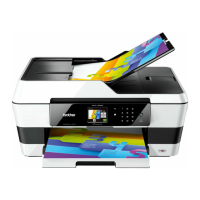
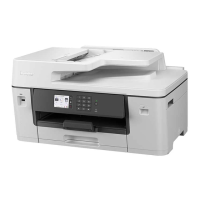
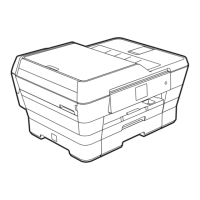


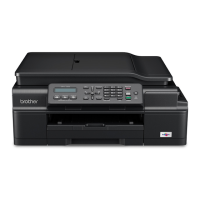
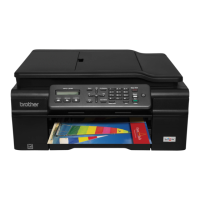
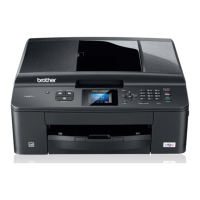
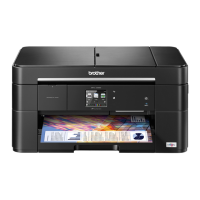
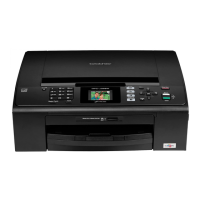
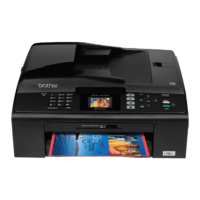
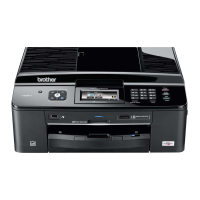
